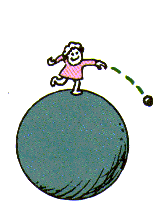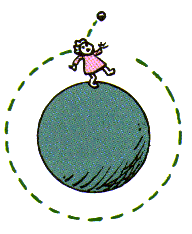Projectile
Orbits and Satellite orbits
Newton had observed that any projectile launched horizontally is, in
a sense, an Earth satellite.
A rock thrown from a tall building sails in a modest orbit that soon
intersects the earth not far from its point of launch.
If the ball were fired more swiftly to start with, it would travel
further. Futher increasing the speed would result in ever larger, rounder
elliptical paths and more distant impact point. Finally, at one particular
launch speed, the ball would glide out just above the planet's surface
all the way around to the other side without ever striking the ground.
At successively greater launch speeds, the ball would resolve in ever-increasing
elliptical orbit until it moved so fast initally that it sailed off in
an open parabolic or (if even faster) into a still flatter, hyperbolic
orbit, never to come back to its starting point.
This java applet let you change the launch speed by mouse click.
click + to increase launch speed.
click - to decrease launch speed.
Then Press Start to fire the ball.
Press Reset to change parameters back to default values.
The red arrow represents the velocity vector.
Click the left mouse button near the tip of the
arrow and drag the mouse to change its velocity.
Click right mouse button to stop the animation, press it again to resume.
When will the ball start to go around without striking
the ground?
When will the motion become a circular motion? Enjoy
it !
Try to click the full checkbox, and find out what will happen.
Your suggestions are highly appreciated! Please click hwang@phy03.phy.ntnu.edu.tw
Author¡GFu-Kwun Hwang, ( click for more physics related java applet )
Dept. of physics, National Taiwan Normal University
Last modified :

